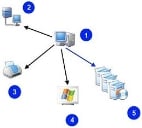CI structures
One of the key benefits that configuration management provides is the modeling of relationships between IT components. After you have identified these relationships, you can create connections between CIs to model the real-world situation. For example, a workstation is made up of a desktop computer, operating system and software applications. The workstation is connected to and uses the network. The proper understanding of relationships between IT components makes it possible for you to perform detailed impact analysis on a proposed change.
- Workstation
- Network Server
- Network Printer
- Operating System
- Software Applications
Configuration management enables you to manage the IT components and relationships that you create, which is particularly useful for Change and Problem management. For example, if you make a change to a CI, you can use the defined relationships to assess the impact of the change on other components. You can also use configuration management to identify which CIs are the root cause of incidents and so on.
You can link CIs into a structure in a variety of ways. In the diagram below, a printer is connected to a PC. The PC is the parent of the printer; the printer is the child of the PC.

- Parent
- Child
When you link two items together, the item that you select first is automatically made the parent CI. The relationship arrow points in the direction of impact. In other words, it shows that the child CI is affected if something happens to the parent CI, but not the other way around.
